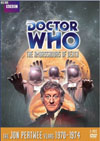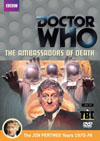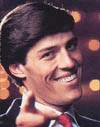DVD features include:
Title Experiments and the Science of AnchoringThis story tries some more new experiments with the title sequences, and like "Citizen Kane", it has become best remembered for the less successful ones we have not learned to take for granted in subsequent stories, such as the fact that the title sequence comes back between the reprise of the previous week's cliffhanger and the start of the current episode's new material. This order of doing things is not totally new, as many 1960's stories opened with similar title logic - the only difference is that the titles here are accompanied by a return to the "vortex" graphics and Ron Grainer's theme song, instead of being superimposed over a standard establishing shot or the main action.In terms of titles, what we should really notice is that this is the first story to use the electronic "scream" sting to lead into the familiar Doctor Who theme song, a move so successful that it has been reused, and later imitated, in EVERY Who story the BBC produced since. It's particularly hard to miss in this story, as it gets aired during the curiously delayed episode titles as well as on the end credits. The full psychological importance of this sound is worth discussing, and this is the time and place to do it. This sound becomes THE musical "sting" to signify an episode cliffhanger, and is one of the best cinematic examples of psychological "anchoring" that I know of.
And so, one of the key factors missing from Michael Ferguson's previous story "The Seeds of Death" (story no. 48) in its video-released movie compilation form is precisely the same factor that his next story "The Ambassadors of Death" can be proud to have made pioneering improvements on.
The Hulke FilesAlright, "Ambassadors" is more than titles and credits. It's a darn good story as well. We have here the most detailed examples of space travel in any UNIT story getting linked into a good conspiracy mystery, with a healthy dose of Martian unknown thrown in for good measure. X-Files, eat your heart out. Anticipation remains high throughout the story, and it also has a particularly good resolution in which the action supports the thematic elements so that both can be successful and satisfying. The road getting there is still a bit touch and go however.A lot of strange dynamics are at work in the plot, helping to keep things quite interesting for sure, somehow very reminiscent of Whitaker's efforts for the Patrick Troughton era. Once again, "correct" answers come to the minds of the characters without them doing on-screen investigation or having any direct evidence in support of their conclusions, making them look as though they can somehow read Whitaker's mind. The script does however manage to do quite a few backflips and somersaults to hang onto the logic of it all, managing it barely but successfully nevertheless. I've seen it written that Malcolm Hulke did "script editing" rewrites on episodes 2 through 7 (while Terrance Dicks' assistant Trevor Ray patched up episode 1). A few of Hulke's trademark raise-the-stakes and slap-the-protagonists-back-to-square-one devices now start to glue the plot together more firmly. I highly suspect that this collaboration of two and three writers helped make "Ambassadors" such a strong story, even if Whitaker took the need for re-writes personally and disapproved. The "Ambassadors" story is quite a successful endeavour, a unique marriage of genres and subject matter, and a jolly worthwhile tale. As directing goes, Michael Ferguson turns in one of his better efforts for the program here, perhaps topped only by "The War Machines" (story no. 27), although the rest of season seven will surpass his work in the directing department. Cutting into Ferguson's ratings is the transitional style: he often shows a character who just goes on doing whatever he or she is doing, and without anyone commenting on it - in effect this is dramatic inertia. Too much of this does add up. At times, whole sequences are composed of this style of shot, and it is up to the audience to remember what might possibly happen next to keep themselves in suspense. This is harder to do on repeat viewing, when the basic outcome is known and the tension is less apparent. This cinematic style typically benefits musicians, however, and Dudley Simpson makes the most of the opportunity he finds here to create themes for the characters and play them at their full length in the finished product with little interruption from dialogue or action. The "Ambassadors" score is one of the most entertaining that Simpson has come up with, offering us the definitive version of a new UNIT theme, a VERY effective sleepwalk theme for the alien ambassador astronauts, and some really swingin' links and stings to put a 60's secret agent feel to the whole thing. Sound effects man Brian Hodgson takes over in providing many of the more alien scenes with a different auditory ambience, keeping the mixture of moods in the story fresh.
Also, in terms of classic formulas, any good hero MUST make a dramatic final exit to separate himself or herself from the good average citizens he or she has just helped out. The Doctor is all set to slip away before the excitement of the climax cools off, but wait - this is the new exile format and the TARDIS can't quite give him his usual hero's exit. He leaves just as quickly anyway, rushing back to the lab to go tinker with the disabled time-machine. On this occasion, his abandonment of the other characters appears particularly contrived to fit old formulas. But, dang it, those old formulas still work, and manage to give "Ambassadors" a good closing scene.
The CastThe acting is fairly exceptional from the main cast in this one, going a bit better than "Spearhead From Space" (story no. 51). John Abineri, who last made an excellent Van Lutyens in "Fury From the Deep" (story no. 42), returns to give his definitive Doctor Who performance as General Carrington. Abineri adds much to the thematic weight of the story, and he succeeds in his role beautifully, credibly, and sympathetically. Michael Wisher debuts on the program applying the natural charisma of his usual stern visage and meticulous, light line delivery. His beard is a nice touch, setting his TV reporter character apart from the many others he would play on the program in a very short space of time. Cyril Shaps plays virtually the same worry-worn character as he did in "The Tomb of the Cybermen" (story no. 37), now under the new name of Doctor Lennox, and manages to make an equally watchable job of it. William Dysart seems perfectly cast for the multi-talented criminal Reegan, fully capable of charm, yet resorting to force more often than not with that chip on his shoulder against most of society. The role of Bruno Taltalian, although a bit touch and go at times, also seems capably done.Chiefly it is the extras and really minor characters who are not quite up to par, including "Action by Havoc", where the choreography, photography and blocking out of shots often doesn't enhance the drama very well, often becoming hammy or quite improbable and "unsoldier-like". John Levene makes a brief return as Sgt. Benton, only in episodes 5 and 7 and only in the studio. His absence from the final location battle seems very much to be more a production consideration than one of plot logic. Benton still seems a bit rough around the edges, but not by very much. The most enigmatic acting in terms of appreciability comes from Ronald Allen, last seen sporting the huge shoulders of Dominator Rago (in "The Dominators", story no. 44), now playing British Space Controller Ralph Cornish. The Cornish character has come out of Whitaker's average-Joe factory mould without any dings or dents, so obviously he is meant to be the understatedly attractive straight man guest star for the story. He doesn't get a factory mould average-Jane character to play against, which is possibly a blessing considering past Whitaker efforts in this arena. In fact Cornish is single-mindedly job-focused all through the story, and receives no challenges to this philosophy to give his character some personal drama. He is rather blandly conceived in the scripts to begin with; what can an actor do with that? In consideration, Allen's performance is not at all bad, but lacks the same levels of intrigue found in most of the other characters of the story.
Cliffhanger Edits and Padding"The Ambassadors of Death" gives us the best cliffhangers of the Jon Pertwee Era so far. Cliffhanger endings for episodes three and four each have both a perfect edit and a botched one - you can read more details about that in the In-depth Analysis version of this review.The story enters a bit of a slump after the middle section, with the Doctor threatening to become the Man of Sleep while the Amazing, Stupendous Reegan takes over the show to astound us with his acrobatics and feats of physical wheel-turning strength.... (Can't say quite as much as I want about that here without delving into spoilers, so you'll have to turn to the In-depth Analysis version of this review for all the dirt. But the story soon picks up again, and delivers many of its unique best moments after this, including one of the best uses of Colour Separation Overlay on the show ever. Peter Halliday does some voices again, sounding a little better than the Cybermen from "The Invasion" (story no. 46), but not by much.
This story is available on DVD and VHS video. If you've only seen it on TV in black and white syndication, get yourself a more colourful video and enjoy it closer to the way it was meant to be seen!
Comments on this article are welcome. You may contact the author from this page:
|
|||||||||||||||||||||||||||||









